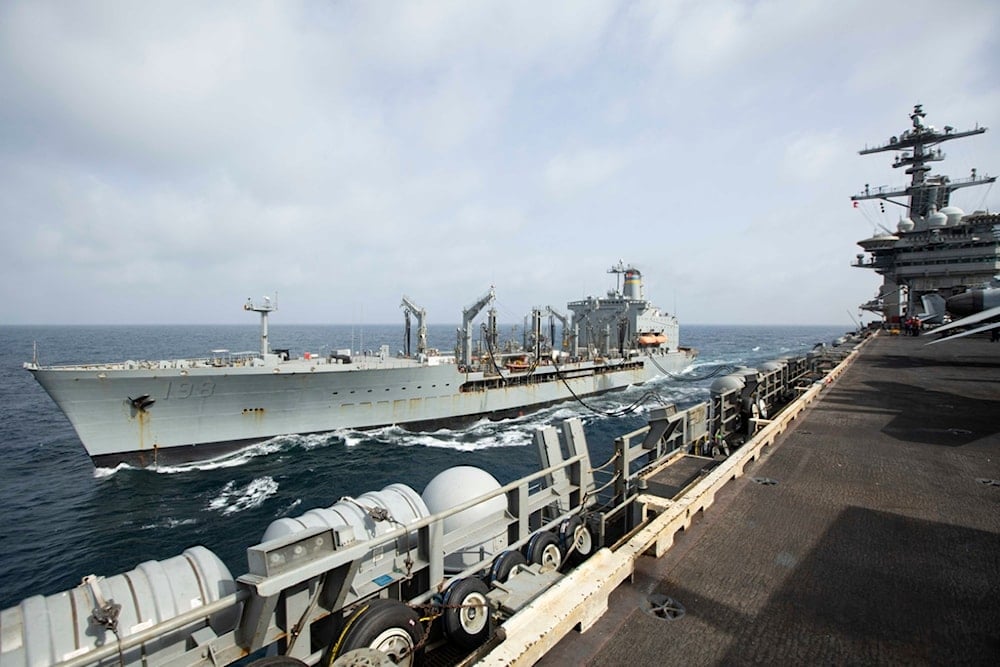Pentagon air-defense stockpiles running low amid high demand: WSJ
The US Department of Defense announced that its stocks of certain air-defense missiles are running low due to increased demand and the potential for further conflict.
-

This handout photo from the US Navy shows the Henry J. Kaiser-class fleet replenishment oiler USNS Big Horn sailing alongside the aircraft carrier USS Abraham Lincoln on September 11, 2024, at an undisclosed location at sea in the Middle East. (AP)
As US-backed wars rage on in the Middle East and Europe, Washington is facing a shortage of key air-defense missiles, raising concerns about the Pentagon's ability to respond effectively to prolonged and future confrontations, as reported by The Wall Street Journal.
The shortage particularly affects interceptors, which have become increasingly critical as the Israeli occupation and other allies contend with increasing missile and drone threats from Iran and its regional allies.
Standard Missiles, primarily ship-launched, are essential for US defense efforts in the region, and they have proven as such, being deployed more than 100 times since October 2023, as per US officials, to defend the Israeli occupation from missile strikes launched from Yemen and Iran.
The missiles have been used to provide security for naval vessels that were barred from passing through the Red Sea, the Indian Ocean, and the Bab al-Mandeb crossing following Yemen's blockade on "Israel" while also defending "Israel" from Yemeni and Iranian missile and drone strikes. Added to those are strikes from the Resistance in Iraq on US bases in the region.
Tensions intensified after recent Israeli strikes on Iran, sparking concerns over further retaliatory attacks by Tehran and potentially exacerbating the demand for these anti-air missiles.
Dwindling defense, strategic blunders
Due to security concerns, the Defense Department does not publicly disclose its stockpiles. However, Pentagon spokesperson Sabrina Singh affirmed the department's commitment to protecting its forces and the Israeli occupation forces.
"Over the course of the last year, the Department of Defense has augmented our force posture in the region to protect US forces and support the defense of Israel, while always taking into account US readiness and stockpiles," she said.
Defense analysts warn that the Pentagon's missile usage rate may outpace its ability to replenish stockpiles, potentially compromising US readiness in other regions, notably the Pacific.
The industrial challenges involved in ramping up missile production further complicate the situation. Expanding production often requires new facilities, additional personnel, and increased investment, which companies may hesitate to undertake without long-term procurement commitments from the Pentagon.
Despite recent efforts to boost stockpiles, the US Navy estimates that over $1.8 billion in interceptors had already been deployed as part of the ongoing Israeli war on Gaza and Lebanon, putting a strain on the nation's defense reserves and raising questions about the sustainability of current defense strategies, especially as the US also provides aid to Ukraine and other NATO states in light of soaring tensions in the region. Another strategic cornerstone is to bolster Taiwan out of fear of possible escalations in the Pacific arena.
"We're spending a year's worth of Standard Missiles -those are standard missiles that are supposed to be part of rearming ourselves for China," said Mark Montgomery, a retired rear admiral and now a senior director at the Foundation for Defense of Democracies. "So, 100%, we have, once again in the Middle East, set back Navy readiness to execute operations in the Pacific."
This comes as the United States deploys Patriot missile-defense systems and THAAD interceptors in the Middle East in order to mitigate strain on Standard Missiles.
Deepening involvement
Earlier in October, Deputy Pentagon Press Secretary Sabrina Singh told reporters that the US was increasing its military presence in the Middle East by deploying a "few thousand" additional troops.
According to a statement, this includes bringing in new units and extending the stay of those already stationed there.
"A certain number of units already deployed to the Middle East region... will be extended and the forces due to rotate into theater to replace them will now instead augment" those that are already there, Singh said.
"These augmented forces include F-16, F-15E, A-10, F-22 fighter aircraft and associated personnel," Singh added, noting that there will be "an additional few thousand" personnel in the region as a result.

 4 Min Read
4 Min Read








